John Hurrell – 21 October, 2016
What was surprising about the show was Roche's lack of interest in his usual practice: that of producing discrete sculptural objects out of folded sheet metal, incorporating light bulbs, LEDs, neon or fluorescent tubes, and covering the form with black or red motifs. Asylum was pointedly an installation that celebrated the peculiarities of the Viaduct space, where one's experience of the encasing six-part Silo architecture was determined by mostly rented sound and light producing objects which were adapted to fit each of the six sections.
Auckland
Peter Roche
Asylum: a multi-sensory art installation
8 October - 16 October 2016 (Art Week)
Down in the Wynyard Quarter section of waterfront - beside the fish and chip shops, tourist wine bars and luxury launch marinas - the Silo cluster of six cement towers (converted into a wonderfully atmospheric tubular gallery) was recently used to present a dramatic new Peter Roche sound and light installation. Each of the cross-sectioned circular spaces had a theme, and was used for great theatrical effect with aural and/or illuminative stimulation, via devices placed on the concrete floor or on the loading chutes positioned overhead.
What was surprising about the show was Roche’s lack of interest in his usual practice: that of producing discrete sculptural objects out of folded sheet metal, incorporating light bulbs, LEDs, neon or fluorescent tubes, and covering the form with black or red motifs. Asylum was pointedly an installation that celebrated the peculiarities of the Viaduct space, where one’s experience of the encasing six-part Silo architecture was determined by mostly rented sound and light producing objects which were adapted to fit each of the six sections.
The different combinations of flashing light and piercing (or rumbling) sound interpenetrated within the cluster of huge vertical cylinders so that linking open doorways and reverberating cement walls almost created a holistic experience. The imposing circular partitions succeeded in preventing that.
Roche‘s enclosed sub-themes were presented in three linked-up pairs: Meltdown / Flotilla; Freedom Bell / The Whistleblowers; The Seven Seas / Tempest. These themes had current global, ecological, World Wide Web, political and military resonances, sometimes poetically alluded to and rarely baldly stated.
Meltdown featured a ‘hotbox’ on a trolley that was part of Roche‘s exhibition at the Saatchi & Saatchi Gallery a few years ago. Its flashing red neon glass loops, in the box and below near the floor, were countered by two flashing suspended lamps hanging off the walls. The title reminded us of a potential nuclear power-station catastrophe.
Flotilla, with its links to naval strategy, was mostly a sound work, a continuous shower of water pouring off a loading chute and plummeting into a foxhole of plastic sandbags enclosing a splashing pool with 13 flashing LEDs. The noise was deafening.
Freedom Bell presented the deep vibrating sound of a sonorous chiming bell, coming from a ring of six speakers positioned high up. A spot also from above aimed a beam at a puddle on the concrete floor, causing reflected ripples to move up and down the opposite wall.
The Whistleblowers had three huge electronic (bright red) whistles that were activated by movement detectors and guarded by a netting fence; their shrill piercing whistle was excruciating, more shocking if you unexpectedly activated it. It would drive many from the space, some perhaps from the building.
In the fifth enclosure, also protected by a fence, seven churning, grinding, red concrete mixers acoustically dominated. The Seven Seas provided deep bassy rumbles from incessant scouring - like turbulent crashing waves - and stroboscopic flashes of white light flickered from underneath. The murmuring scraping sound never stopped, and was heard constantly in all parts of the space. See video here.
Tempest seemed to have been named after Bob Dylan’s song about the Titanic. It had an apocalyptic feel, the final demise of human life on the planet, with ‘sheet lightning’ coming in unpredictable bursts from the nooks and crannies of this silo’s chute. There was no added sound, only the aural treatments from The Whistleblowers and Seven Seas on either side.
There was an impressive economy of poetical means with this Roche show: no flab or clutter, with a precise focussing on the requirements of each of the six circular locations. All individual connected units, yet spreading beyond, providing great cohesion and - though austere - satisfying mental/physical wallop.
John Hurrell
Recent Comments
John Hurrell
It is terrible to hear of Peter Roche's passing. A great uncompromising artist and a particularly warm and generous man--he ...
Kees Snelders
Fantastic mindblowing works.
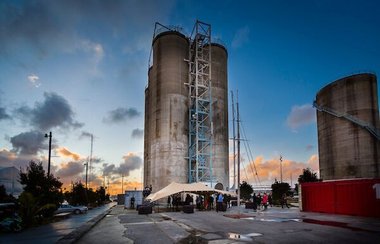


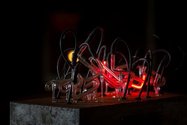
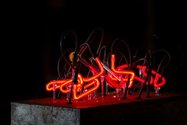





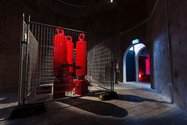
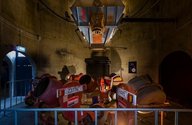
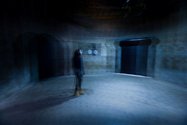
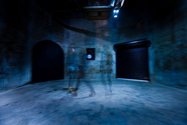
 Advertising in this column
Advertising in this column Two Rooms presents a program of residencies and projects
Two Rooms presents a program of residencies and projects



This Discussion has 2 comments.
Comment
Kees Snelders, 8:36 p.m. 26 October, 2016 #
Fantastic mindblowing works.
John Hurrell, 11:29 a.m. 26 July, 2020 #
It is terrible to hear of Peter Roche's passing. A great uncompromising artist and a particularly warm and generous man--he will leave a huge gap. We are living in an era where art is dominated by Sunday school teachers working with the most obvious narratives, and oblique confrontational work is not countenanced. This is the result of bullies like Trump who have globally contaminated the discourse so only two opposing camps remain. Peter's leaving is a real loss for our culture.
Participate
Register to Participate.
Sign in
Sign in to an existing account.